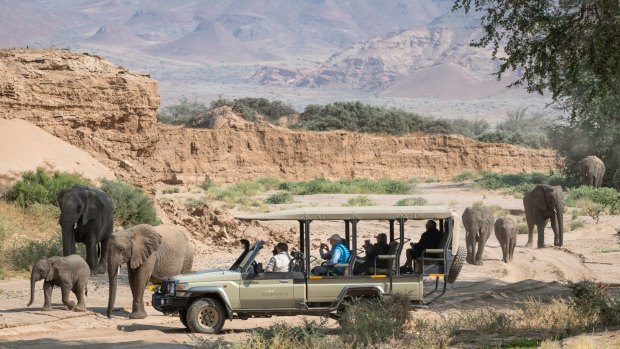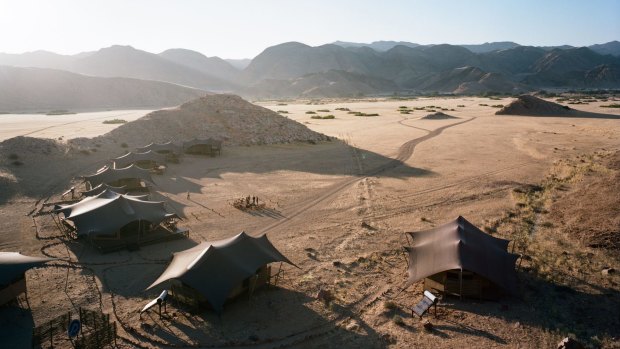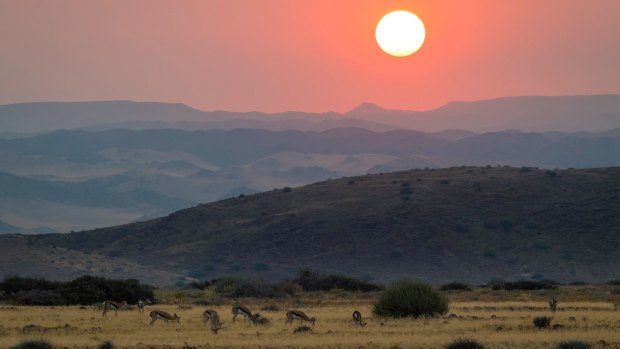This was published 4 years ago
Namibia Sustainable Road Trip: A unique and enticing destination for travellers
By Nina Karnikowski

Damaraland elephants.
Just before dusk, we meet a group of eight white rhinoceros. Our safari truck shudders to a halt and my guide jumps out, just 30 metres away. I follow, tentatively, and we watch two baby rhinos tussle in the dust as the setting sun turns it to gold. Within minutes, an adult ambles towards us, stopping only when it's so close we can hear it sniffing the air for our scent. Fear quickly dissolves into gratitude as I remember how rare it is to get so close to this near-threatened species.
This, I soon learn, is one of the elements that makes Namibia such a unique and increasingly enticing destination for travellers. Since gaining independence from South Africa in 1990, the country has been leading the way for conservation. Realising the vital role wildlife and landscapes play in attracting tourism, it was the first nation in the world to write provisions for environmental protection and conservation of natural resources into its constitution.
Community conservancies and privately-owned nature reserves - like the 9000-hectare Zannier Reserve the rhinos are on, which rescues injured and unwanted animals – now cover about a sixth of the country's entire land mass. So, while for most of Africa the conservation situation is bleak, in Namibia wildlife populations have grown, local incomes and quality of life have risen dramatically, and the economic outlook for the whole country has improved.

Hoanib Valley.Credit: Michael Turek
My home for this evening is the extraordinary new Omaanda lodge, set inside the Zannier Reserve. A joint venture between French company Zannier Hotels and the Naankuse Wildlife Foundation, which runs a sanctuary next door, Omaanda is one of an array of Namibian lodges helping wildlife populations and tribal communities flourish.
When I return to Omaanda post-rhino encounter, I eat a delicious oryx steak with ratatouille by the fire in the dining tent, then stargaze from the bathtub inside my elegant thatched clay hut, which takes its design cues from the homes of Namibia's Owambo tribe. At sunrise, I sit on my deck watching warthogs snuffle in the dirt and kudu drink from the waterhole, and gaze out across the savannah. I'm only half an hour from the airport, but already I feel swept away by Namibia's great nothingness.
Along with wildlife, Namibia's growing tourism industry is also helping to protect these landscapes. Later in the morning, my local Bench Africa guide Nestor Nghuunduka and I begin driving through them, as we embark on our 12-day road trip through the northwest of the country. Mining, Nestor tells me as we drive, is Namibia's biggest industry, contributing to 25 per cent of its gross domestic product due to vast natural resources including diamonds, uranium and gold. But, he adds, the value these landscapes hold for tourism, about 14.5 percent of the GDP, has stopped the government from letting them all be plundered by mining.

Antelopes at sunset.
By the time we reach Etosha National Park some six hours later, I understand why. Ethereal plains stretch out around us, their only boundary the arc of cloudless sky. High amounts of limestone and salt in the earth translate to a stark simplicity of colours – white earth, blue sky, the occasional light green spritz of saltbush. As we drive, if we overshoot a turn or need to go back, Nestor reverses to avoid leaving multiple tracks on the earth. They can take a lifetime to heal, he says. It isn't until we reach a waterhole that life suddenly appears. The black and white zigzag of zebras, the tawny slick of elegant springboks, the black puff of an ostrich.
From Etosha we drive southwest to Damaraland, the terrain shifting from white to iron-rich red. We bump along gravel roads, passing jagged shale mountains, remote mud-hut villages, makeshift crystal stalls made from sticks and ragged cardboard and the occasional local - always smiling, always waving.
We have entered Torra Conservancy, says Nestor, home to 1200 residents and one of the first of 86 self-governing conservancies now spread across Namibia. If you live in a conservancy, he explains, you financially benefit from the tourism development that happens inside it, which is why the model works so well. "The residents of Torra now have electricity, water pumps, solar panels and food, mostly because of tourism," says Nestor. "That's why they look very happy to see us."
Our next stop, Damaraland Camp, eventually emerges from a fold in the Huab River Valley. When it opened in 1996, as a partnership between luxury outfitter Wilderness Safaris and the Torra Conservancy, it was the first camp in Namibia to be owned and mostly operated by locals, with 45 per cent of the profits going back to the community. It quickly became an inspiration for conservationists across the continent. After 24 years of operation, and thanks to a recent refurbishment, it also remains eminently stylish. My thatched-roof khaki canvas tent is one of 10 (the maximum room number for conservancy camps) scattered through the ruddy landscape, with light-wood floorboards, a large ensuite bathroom and sweeping mountain views from the deck.
In the afternoon, Nestor and I hike up one of those mountains. Our boots crunch over lumps of glistening quartz, as we pass squat shepherds bushes and brigades of ants marching into their nests, each bearing chunks of earth twice their size.
Next morning we drive to a mountaintop at dawn, where camp staff have set up a breakfast buffet so we can eat our eggs, toast and coffee while watching the sun rise above the Etendeka mountains. Afterwards, we venture into the surrounding plains to track desert-adapted elephants, whose numbers have increased several times over since the early '90s thanks to the conservancy model.
Since tourists coming to see these animals translate to a direct financial benefit for the community, locals are doing whatever they can to keep them alive. I am infinitely thankful for that as I watch the extraordinary creatures - who survive on about a sixth of the water elephants usually guzzle and feed far less - curl their crumpled trunks around prickly acacias.
It is late afternoon when we arrive at Hoanib Valley Camp, set deep in the Kaokoland Desert, filled with unique wildlife and nomadic Himba tribal settlements. Backed by soaring granite mountains and with an empty plateau stretching out ahead towards the Hoanib River, the six tented rooms are sophisticated yet simple, blending seamlessly into the landscape.
Open since June 2018, Hoanib Valley Camp is another joint venture between the local community, who compose 90 per cent of staff, and the Giraffe Conservation Foundation, the only Africa-wide giraffe conservation organisation. It is also impressively clean and green - the whole place can be easily disassembled, it's run 100 percent on solar power, and water is sourced entirely from a river bore hole.
I have tea in the central tent, so artfully curated I feel I'm in a Peter Beard artwork, then head out for a walk with camp manager, Festus Mbinga. As we stroll, keeping one eye peeled for desert-adapted lions, Festus points out oryx droppings, bushels of wild sage and termite nests, as he speaks of how Hoanib Valley Camp has improved life in the valley. At one point, he stops and leans forward in the twilight, his graceful hand gestures unfolding at half speed. "Ecotourism here in the valley has enhanced education and financially benefited local people; very few industries can penetrate that deep," he says, his palms catching the dying light. "It is truly a life-changing opportunity for my people."
TRIP NOTES
FLY
South African Airways flies from Perth to Johannesburg daily (11 hours), then connects to a two-hour flight to Windhoek. See flysaa.com
TOUR
Bench Africa's 12-day privately-guided Namibia in Style road safari includes most meals, airport transfers and game drives. From $13,810 per person; see benchafrica.com
MORE
Nina Karnikowski travelled as a guest of Bench Africa.
FIVE MORE NAMIBIAN ROAD TRIP MUSTS
TWYFELFONTEIN ENGRAVINGS, DAMARALAND
These UNESCO-listed rock engravings date back 6000 years, to when the area was first inhabited by nomadic hunter-gatherers. Africa's largest collection of petroglyphs, they feature rhinos, giraffes, footprints and more.
HIMBA VILLAGE, KUNENE
Visiting the Himba tribe, known for their elaborate hairstyles and ochre-covered bodies, you will be welcomed into their village to learn about their unique, and quickly disappearing, way of life.
'BIG DADDY' DUNE, SOSSUSVLEI
It takes an hour to climb 325-metre Big Daddy, the tallest of Sossusvlei's dunes, but less than five minutes to run down. There you'll find Deadvlei, a clay pan spiked with dead trees trapped in the clay up to 900 years ago.
SKELETON COAST
Shipwrecks, whale bones and plane skeletons dot the Skeleton Coast, famous for its high winds, dense fog and forceful currents. Try to work in a stay at stunning Shipwreck Lodge; see shipwrecklodge.com.na
SWAKOPMUND
A reminder of Germany's colonial claim to Namibia over 100 years ago, visit this pretty port town for German architecture, sandboarding in the surrounding desert and seafood feasts at waterfront restaurants like The Tug. See the-tug.com
Sign up for the Traveller Deals newsletter
Get exclusive travel deals delivered straight to your inbox. Sign up now.